SWITZERLAND
FALLS
|
ALL ABOUT SWITZERLAND |
|
RHINE FALLS |
|||||
Neuhausen am Rheinfall, Schaffhausen, SwitzerlandThe Rhine Falls, Europe's largest water falls, are a major tourist attraction in northern Switzerland. Situated at Neuhausen am Rheinfall, near the city of Schaffhausen, they are easily reached from Winterthur in 25 minutes (by train) and from Zurich in one hour.
|
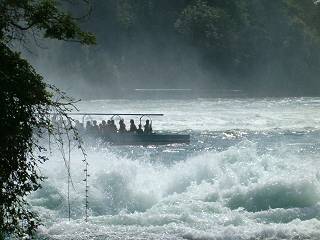
|
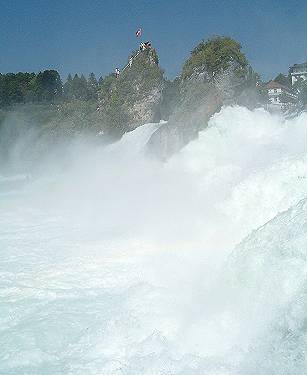
|
|
The taller of the two rocks is accessible by boat. You may climb the stairs just to its top which is decorated - inevitable in Switzerland - with a flagpost. Looks a little more dramatic than it really is - a quite safe adventure compared to river-rafting. |
| Width | 150 m | [164 yards] |
| Height | 23 m | [75 ft] |
| Depth of the pool | 13 m | [43 ft] |
| Average flow rate, summer | 600 m³/sec | [21,000 cubic ft/sec] |
| Average flow rate, winter | 250 m³/sec | [8,000 cubic ft/sec] |
| Maximum flow rate (1965) | 120 m³/sec | [43,884 cubic ft/sec] |
| Minimum flow rate (1921) | 95 m³/sec | [3,335 cubic ft/sec] |
Pictures shown on this page were taken on August, 18th, 2005 at a flow rate of 362 m³/sec
[12,709 cubic ft/sec].
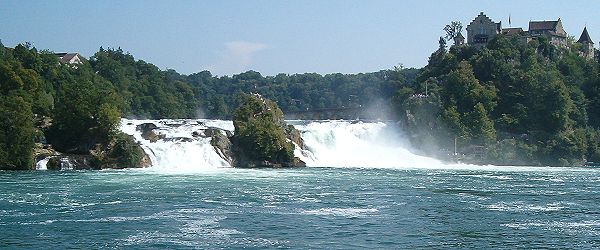
Rhine Falls with rocks (center) and Laufen castle (top right) seen from the right shore.
| By train / public transport | By car | |
|---|---|---|
| In summer (April - October) > use intercity (IC) trains to Winterthur (or Schaffhausen) > use connecting S-Bahn trains S33 Winterthur-Schaffhausen to Schloss Laufen am Rheinfall (25 min from Winterthur) departures from Winterthur: every hour at .06 and .42 minutes > footpath (5 min) from Schloss Laufen station to the castle on the hilltop > Timetables |
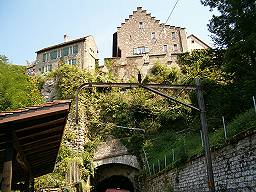 Laufen castle seen from its train station |
Get maps at www.ortsplan.ch and search for > ZIP 8212 City Neuhausen Street Rheinfallstrasse (for access to the right shore) > ZIP 8447 City Dachsen Street Lauferstrasse (for access via Laufen castle, left shore) |
In winter a visit is not so spectacular. Therefore S33 trains do not stop at Laufen castle. You might get to the Rhine Falls anyway by taking a intercity train to the city of Schaffhausen and from there a bus to Neuhausen am Rheinfall. Local buses stop in the town, however, and you will have to walk about 15 minutes from a bus stop to the Rhine Falls.
Best view is from the platforms ("Känzeli") on the left shore. Access is through Laufen castle, the entrance fee (1 Euro / 1.50 CHF / 2 US $) is well worth the difference.
You can reach the right shore from Laufen castle on a paved footpath alongside the railway bridge. Cars must use the next bridge in Schaffhausen city, however.
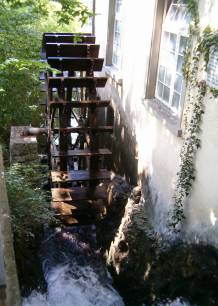
|
The use of waterpower has a long tradition in Switzerland. A mill driven by the waters of River Rhine near the Rhine Falls is mentioned in old documents as early as 1052. In 1404 other crafts using hydropower like grinding and forging are documented. In 1889 Europe's first industrial aluminium production plant was built next to the Rhine Falls. A sculpture designed by Ernesto Hebeisen was erected on the lawn on the right shore to mark the 100th anniversary of the industry. A modern subterranean hydroelectrical power plant next to the Rhine Falls produces some 40 million kWh of electrical energy per year. |
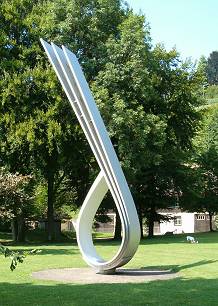
|
 |
Tourist Office |

Short quotations allowed but with precise declaration of origin (Link).
Reproduction of substantial parts and pictures in printed or electronic form
only with explicit written consent by the editor.
| Disclaimer | Privacy Policy | www.all-about-switzerland.info © 2005-2010 All Rights Reserved | Editor | ||